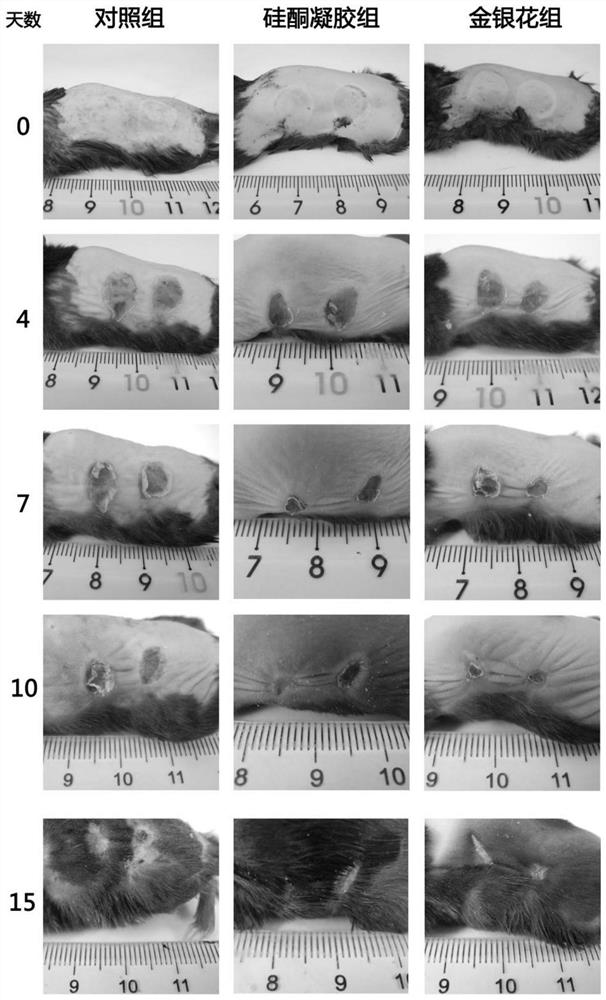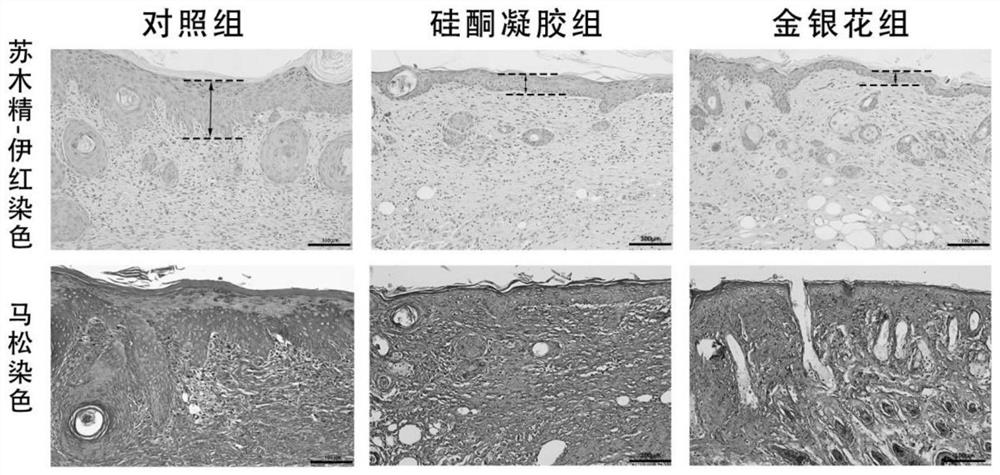Preparation method of honeysuckle flower extract and application of honeysuckle flower extract in preparation of medicine for preventing or treating scars of burnt or scalded skin
A honeysuckle extract and technology of honeysuckle, applied in the direction of drug combination, skin diseases, medical preparations containing active ingredients, etc., can solve problems such as difficult wound healing
- Summary
- Abstract
- Description
- Claims
- Application Information
AI Technical Summary
Problems solved by technology
Method used
Image
Examples
Embodiment 1
[0018] Preparation of Honeysuckle Extract
[0019] Put 5-10 grams of dried honeysuckle in a casserole, add 50-100 ml of ultra-pure water to immerse the honeysuckle in the water, put it on an induction cooker with a power of 1800-2000 watts and boil it for 20-40 minutes, the boiled liquid will pass through 8-16 layers The gauze is coarsely filtered, the liquid is centrifuged at 20-25°C and 5000-8000 rpm for 5-10 minutes, and then the liquid is placed at -80°C for 3-5 hours and placed in a freeze dryer for 1-2 days. Obtain honeysuckle extract.
Embodiment 2
[0021] Animal treatment experiment: The effect of honeysuckle extract on skin healing and scarring of scalded mice, including steps:
[0022] 1) Normal male C57BL / 6 mice aged 6-8 weeks and weighing 20-25 grams were purchased from Jiangsu Jicui Yaokang Biotechnology Co., Ltd., and the mice were randomly divided into 3 groups for feeding. Mice should be acclimated to the environment for at least three days and drink normal sterile water before starting the modeling.
[0023] 2) Create a scald model: shave the normal C57BL / 6J mice that have adapted to the environment, and use depilatory cream to further clear the back hair of the mice, so that the back skin of the mice is exposed, and a round metal rod with a diameter of 2 cm is placed in boiling water. Heat to about 100°C, and quickly place a hot metal rod on the back skin of the mouse for 10 seconds, showing a circular burn mark.
[0024] 3) Wound treatment: On the first day after the establishment of the mouse scald model, ap...
Embodiment 3
[0029] Using hematoxylin-eosin staining method, the skin changes of the mice in Example 2 were observed.
[0030] Hematoxylin-eosin staining can be used to stain tissue for pathological diagnosis. There are thicker epidermis and dermis in scalded skin tissue. The collagen fibers are dense and the collagen bundles are irregularly arranged.
[0031] 1) Cut the injured skin of the mouse back and place it in a 4% paraformaldehyde solution for 12 hours, followed by gradient dehydration: 70% ethanol for 30 minutes → 75% ethanol for 30 minutes → 80% ethanol for 30 minutes → 85% ethanol for 30 minutes × 2 → 90% ethanol for 30 minutes → 95% ethanol for 30 minutes → 100% ethanol for 30 minutes × 2 → ethanol: xylene (1:1) for 30 minutes → xylene for 10-15 minutes → xylene: paraffin (1:1) 30 minutes→paraffin I1h→paraffin II 1h, followed by skin embedding in a small iron box using 75% paraffin.
[0032] 2) Sectioning: Use a paraffin microtome to cut out 5-micron sections of tissue, plac...
PUM
 Login to View More
Login to View More Abstract
Description
Claims
Application Information
 Login to View More
Login to View More - R&D
- Intellectual Property
- Life Sciences
- Materials
- Tech Scout
- Unparalleled Data Quality
- Higher Quality Content
- 60% Fewer Hallucinations
Browse by: Latest US Patents, China's latest patents, Technical Efficacy Thesaurus, Application Domain, Technology Topic, Popular Technical Reports.
© 2025 PatSnap. All rights reserved.Legal|Privacy policy|Modern Slavery Act Transparency Statement|Sitemap|About US| Contact US: help@patsnap.com


